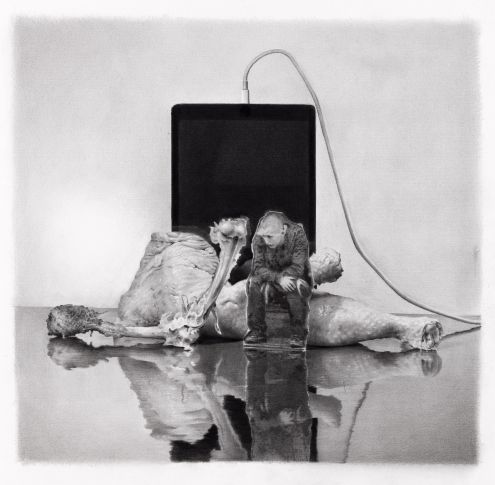A fragile membrane, an illusive screen
David Haines

A fragile membrane, an illusive screen
David Haines
Amsterdam, 2 Sep - 14 Oct '17
“Now, this image of ourselves is obviously not ourselves, anymore than an idea of a tree is a tree, anymore than you can get wet in the word water.” - Alan Watts quoted in ‘Two Way Mirror,’ a two channel video installation by David Haines
Upstream Gallery presents A Fragile Membrane, an Illusive Screen a solo exhibition of new works on paper, wall drawings and two channel video by British/ Dutch artist David Haines.
Every new medium is a Russian doll. The radio and the cinema sit inside every television, just as the television sits inside your smart phone. Because there have been so many Russian dolls over the years, each containing the other, it’s easy to forget that the mirror is a medium, or that the simple act of making marks on paper is a technology. David Haines invites us to consider these things in the reflection of the black mirror.(1) We carry the black mirror everywhere. It blindly reflects our image when it sleeps and every time we wake it up (with the swipe of a finger) it illuminates our desires. It sorts our personal chaos into order. The black mirror is a good servant. It files, classifies, orientates, and informs. In this respect the black mirror surpasses its master. Because the black mirror’s actions are unconscious, it is able to chart a map of the unconscious.
In a group of portraits, images taken from a cam sex site, a series of young men look at themselves. The view is parallax, Narcissus is refracted. A man, his face in repose, gazes at the camera on his laptop. To see himself he must look away from the eye that records his image. We see a boss-eyed double image through the layers of mediation, the video and the shiny glass, the code churning unconsciously beneath the surface.
We never see ourselves, and when we see ourselves the image we see is not part of us. You might catch your image on the surface of a still pond. You may surprise your self as you lope past a shop window; your image may move unexpectedly on a Skype call; you may see your ghost on the black mirror of a sleeping smart phone. Our image is always mediated, always de-centered. Our image is reserved for others and implicitly addressed to others. Because the black mirror extends us and because it surrounds us we forget that, like every interactive technology, the black mirror is a technology of self. It records an image of us whilst simultaneously constructing us, presenting us, and teaching us how to behave.
A series of Trompe-l'œil drawings, Still Lifes with Flyers, are unlike Haines’ other portraits, they do not survey an interior, subjective, space. The bodies are on display, they project an image produced explicitly for others. But the medium on which the image is carried tells a specific history. It records the wear and tear of being folded, it tells the story of its circulation as a medium; this is in turn translated into a drawing.
A further series of still life drawings, this time with iPads, screens, cutouts, meat and bones takes this abstraction further. This is not a formal abstraction – in the sense that they divert from realistic depiction or break down into simple forms – but rather they invite us to read images of ‘real things’ on different registers: as things in ‘real space,’ as reflections of those things, as two dimensional cut-outs nested within a prospective three dimensional space. In the two large drawings Meatboy and Bob Starr and Your Fluffer the moiré pattern (the matrix of the printed image) slips between the register of dots and the register of an image. This is set against figures of a much finer definition where graphite and the grain of the paper tangle in a tight net of information.(2)
As we travel through the different levels of abstraction the subject is mediated and remediated. Of course, the image is not the thing it depicts, any more than the menu can be mistaken for the meal, or the map mistaken for the territory it charts.
In Haines’ work every medium reflects another but this does not leave us abandoned in a hall of mirrors because we are grounded in the materiality of the drawings, we are drawn to the specificity of the medium – this particular sheet of paper, these specific particles of graphite.
If every image draws us to a receding horizon, beyond which the ‘real thing’ is situated, in Haines’ work we comprehend the different levels of abstraction that allow us to negotiate with the reflection of ourselves that is always fugitive, always extensive: a projection, a reflection, an image in process.
Steve Rushton, August 2017
Steve Rushton’s Masters of Reality is published by Sternberg Press
(1) Charlie Brooker on his TV show Black Mirror: “If technology is a drug – and it does feel like a drug – then what, precisely, are the side-effects?” The Guardian 1/12/2011
(2) Here I use ‘abstraction’ in the sense Gregory Bateson’s used it in Steps to an Ecology of Mind (1972) and Mind and Nature (1980). Bateson’s notion of abstraction provides the basis for a holistic aesthetic and ecological epistemology. Bateson identifies Alfred Korzybski as the originator of the phrase the map is not the territory.

